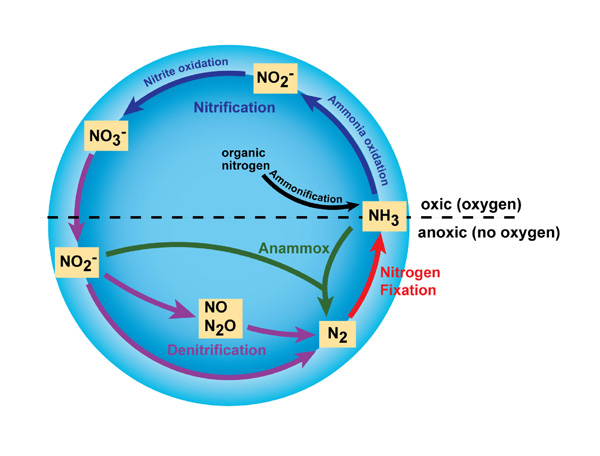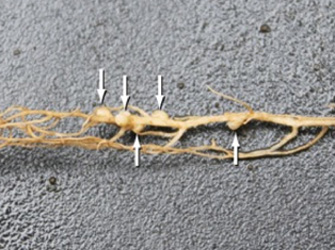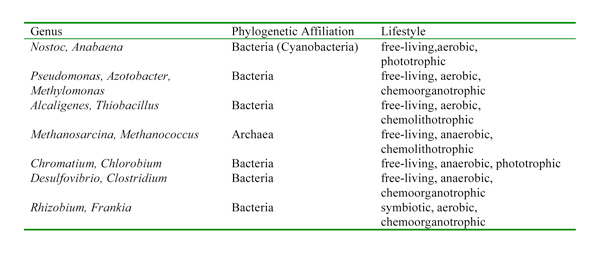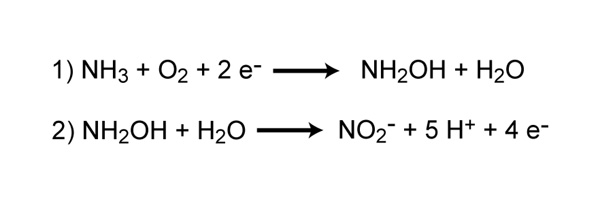in what process do bacteria change nitrogen into a form plants can use
Nitrogen is one of the primary nutrients critical for the survival of all living organisms. Although nitrogen is very abundant in the atmosphere, it is largely inaccessible in this grade to most organisms. This commodity explores how nitrogen becomes available to organisms and what changes in nitrogen levels equally a consequence of homo activity means to local and global ecosystems.
Introduction
Nitrogen is one of the primary nutrients critical for the survival of all living organisms. Information technology is a necessary component of many biomolecules, including proteins, DNA, and chlorophyll. Although nitrogen is very abundant in the atmosphere as dinitrogen gas (Northii), it is largely inaccessible in this form to almost organisms, making nitrogen a scarce resource and often limiting primary productivity in many ecosystems. Only when nitrogen is converted from dinitrogen gas into ammonia (NH3) does information technology get available to primary producers, such equally plants.
In addition to N2 and NH3, nitrogen exists in many different forms, including both inorganic (e.g., ammonia, nitrate) and organic (e.grand., amino and nucleic acids) forms. Thus, nitrogen undergoes many different transformations in the ecosystem, changing from one class to another as organisms use it for growth and, in some cases, energy. The major transformations of nitrogen are nitrogen fixation, nitrification, denitrification, anammox, and ammonification (Figure 1). The transformation of nitrogen into its many oxidation states is key to productivity in the biosphere and is highly dependent on the activities of a diverse assemblage of microorganisms, such as bacteria, archaea, and fungi.

Figure 1: Major transformations in the nitrogen cycle
Since the mid-1900s, humans take been exerting an ever-increasing impact on the global nitrogen wheel. Human activities, such as making fertilizers and burning fossil fuels, have significantly contradistinct the amount of fixed nitrogen in the World's ecosystems. In fact, some predict that by 2030, the amount of nitrogen fixed past man activities will exceed that fixed by microbial processes (Vitousek 1997). Increases in available nitrogen can modify ecosystems past increasing primary productivity and impacting carbon storage (Galloway et al. 1994). Because of the importance of nitrogen in all ecosystems and the meaning impact from homo activities, nitrogen and its transformations take received a cracking deal of attention from ecologists.
Nitrogen Fixation
Nitrogen gas (Northwardtwo) makes up nearly lxxx% of the Globe'due south atmosphere, however nitrogen is often the nutrient that limits primary product in many ecosystems. Why is this so? Because plants and animals are non able to apply nitrogen gas in that form. For nitrogen to be bachelor to brand proteins, Dna, and other biologically important compounds, it must showtime be converted into a different chemic form. The process of converting Ntwo into biologically bachelor nitrogen is chosen nitrogen fixation. N2 gas is a very stable compound due to the strength of the triple bail between the nitrogen atoms, and it requires a large amount of energy to break this bond. The whole process requires eight electrons and at least sixteen ATP molecules (Effigy two). Equally a effect, only a select group of prokaryotes are able to carry out this energetically demanding process. Although virtually nitrogen fixation is carried out by prokaryotes, some nitrogen tin can be fixed abiotically by lightning or certain industrial processes, including the combustion of fossil fuels.

Figure ii: Chemical reaction of nitrogen fixation

Figure 3: Nitrogen-fixing nodules on a clover plant root
Some nitrogen-fixing organisms are free-living while others are symbiotic nitrogen-fixers, which require a shut clan with a host to conduct out the process. Nearly of the symbiotic associations are very specific and take complex mechanisms that help to maintain the symbiosis. For case, root exudates from legume plants (e.yard., peas, clover, soybeans) serve every bit a bespeak to certain species of Rhizobium, which are nitrogen-fixing bacteria. This signal attracts the bacteria to the roots, and a very complex series of events then occurs to initiate uptake of the bacteria into the root and trigger the procedure of nitrogen fixation in nodules that class on the roots (Figure 3).
Some of these bacteria are aerobic, others are anaerobic; some are phototrophic, others are chemotrophic (i.eastward., they apply chemicals as their energy source instead of light) (Table ane). Although there is peachy physiological and phylogenetic diversity among the organisms that carry out nitrogen fixation, they all take a similar enzyme complex called nitrogenase that catalyzes the reduction of N2 to NH3 (ammonia), which can be used equally a genetic marking to identify the potential for nitrogen fixation. One of the characteristics of nitrogenase is that the enzyme circuitous is very sensitive to oxygen and is deactivated in its presence. This presents an interesting dilemma for aerobic nitrogen-fixers and particularly for aerobic nitrogen-fixers that are also photosynthetic since they actually produce oxygen. Over fourth dimension, nitrogen-fixers have evolved different ways to protect their nitrogenase from oxygen. For example, some blue-green alga have structures chosen heterocysts that provide a low-oxygen environment for the enzyme and serves as the site where all the nitrogen fixation occurs in these organisms. Other photosynthetic nitrogen-fixers fix nitrogen only at dark when their photosystems are dormant and are not producing oxygen.
Genes for nitrogenase are globally distributed and take been plant in many aerobic habitats (east.thou., oceans, lakes, soils) and likewise in habitats that may be anaerobic or microaerophilic (e.g., termite guts, sediments, hypersaline lakes, microbial mats, planktonic crustaceans) (Zehr et al. 2003). The broad distribution of nitrogen-fixing genes suggests that nitrogen-fixing organisms brandish a very broad range of environmental conditions, as might be expected for a process that is critical to the survival of all life on Earth.

Table ane: Representative prokaryotes known to carry out nitrogen fixation
Nitrification
Nitrification is the process that converts ammonia to nitrite and then to nitrate and is another important stride in the global nitrogen cycle. Most nitrification occurs aerobically and is carried out exclusively by prokaryotes. There are two distinct steps of nitrification that are carried out by distinct types of microorganisms. The offset step is the oxidation of ammonia to nitrite, which is carried out by microbes known as ammonia-oxidizers. Aerobic ammonia oxidizers convert ammonia to nitrite via the intermediate hydroxylamine, a process that requires two different enzymes, ammonia monooxygenase and hydroxylamine oxidoreductase (Figure iv). The procedure generates a very pocket-sized amount of free energy relative to many other types of metabolism; as a effect, nitrosofiers are notoriously very deadening growers. Additionally, aerobic ammonia oxidizers are also autotrophs, fixing carbon dioxide to produce organic carbon, much similar photosynthetic organisms, simply using ammonia as the energy source instead of light.

Figure iv: Chemic reactions of ammonia oxidation carried out past bacteria
Reaction 1 converts ammonia to the intermediate, hydroxylamine, and is catalyzed by the enzyme ammonia monooxygenase. Reaction 2 converts hydroxylamine to nitrite and is catalyzed by the enyzmer hydroxylamine oxidoreductase.
Unlike nitrogen fixation that is carried out by many different kinds of microbes, ammonia oxidation is less broadly distributed among prokaryotes. Until recently, it was thought that all ammonia oxidation was carried out by just a few types of leaner in the genera Nitrosomonas, Nitrosospira, and Nitrosococcus. However, in 2005 an archaeon was discovered that could also oxidize ammonia (Koenneke et al. 2005). Since their discovery, ammonia-oxidizing Archaea accept often been constitute to outnumber the ammonia-oxidizing Bacteria in many habitats. In the past several years, ammonia-oxidizing Archaea take been found to be abundant in oceans, soils, and salt marshes, suggesting an of import role in the nitrogen cycle for these newly-discovered organisms. Currently, only ane ammonia-oxidizing archaeon has been grown in pure culture, Nitrosopumilus maritimus, so our agreement of their physiological diversity is limited.
The second step in nitrification is the oxidation of nitrite (NO2 -) to nitrate (NO3 -) (Effigy 5). This pace is carried out by a completely separate group of prokaryotes, known as nitrite-oxidizing Leaner. Some of the genera involved in nitrite oxidation include Nitrospira, Nitrobacter, Nitrococcus, and Nitrospina. Similar to ammonia oxidizers, the energy generated from the oxidation of nitrite to nitrate is very minor, and thus growth yields are very low. In fact, ammonia- and nitrite-oxidizers must oxidize many molecules of ammonia or nitrite in order to fix a unmarried molecule of COtwo. For consummate nitrification, both ammonia oxidation and nitrite oxidation must occur.

Effigy 5: Chemical reaction of nitrite oxidation
Ammonia-oxidizers and nitrite-oxidizers are ubiquitous in aerobic environments. They take been extensively studied in natural environments such as soils, estuaries, lakes, and open-ocean environments. Nevertheless, ammonia- and nitrite-oxidizers as well play a very important role in wastewater handling facilities by removing potentially harmful levels of ammonium that could lead to the pollution of the receiving waters. Much research has focused on how to maintain stable populations of these of import microbes in wastewater treatment plants. Additionally, ammonia- and nitrite-oxidizers aid to maintain good for you aquaria by facilitating the removal of potentially toxic ammonium excreted in fish urine.
Anammox
Traditionally, all nitrification was thought to be carried out under aerobic conditions, but recently a new blazon of ammonia oxidation occurring under anoxic weather condition was discovered (Strous et al. 1999). Anammox (anaerobic ammonia oxidation) is carried out by prokaryotes belonging to the Planctomycetes phylum of Bacteria. The first described anammox bacterium was Brocadia anammoxidans. Anammox bacteria oxidize ammonia by using nitrite equally the electron acceptor to produce gaseous nitrogen (Figure 6). Anammox leaner were first discovered in anoxic bioreactors of wasterwater treatment plants but take since been establish in a diversity of aquatic systems, including low-oxygen zones of the sea, littoral and estuarine sediments, mangroves, and freshwater lakes. In some areas of the ocean, the anammox process is considered to be responsible for a significant loss of nitrogen (Kuypers et al. 2005). Withal, Ward et al. (2009) argue that denitrification rather than anammox is responsible for most nitrogen loss in other areas. Whether anammox or denitrification is responsible for about nitrogen loss in the ocean, information technology is clear that anammox represents an of import procedure in the global nitrogen bike.

Figure vi: Chemic reaction of anaerobic ammonia oxidation (anammox)
Denitrification
Denitrification is the procedure that converts nitrate to nitrogen gas, thus removing bioavailable nitrogen and returning it to the atmosphere. Dinitrogen gas (N2) is the ultimate end product of denitrification, merely other intermediate gaseous forms of nitrogen be (Figure 7). Some of these gases, such as nitrous oxide (Due north2O), are considered greenhouse gasses, reacting with ozone and contributing to air pollution.

Figure seven: Reactions involved in denitrification
Reaction 1 represents the steps of reducing nitrate to dinitrogen gas. Reaction ii represents the complete redox reaction of denitrification.
Unlike nitrification, denitrification is an anaerobic process, occurring mostly in soils and sediments and anoxic zones in lakes and oceans. Like to nitrogen fixation, denitrification is carried out by a diverse group of prokaryotes, and in that location is recent evidence that some eukaryotes are also capable of denitrification (Risgaard-Petersen et al. 2006). Some denitrifying bacteria include species in the genera Bacillus, Paracoccus, and Pseudomonas. Denitrifiers are chemoorganotrophs and thus must too exist supplied with some form of organic carbon.
Denitrification is important in that it removes fixed nitrogen (i.e., nitrate) from the ecosystem and returns it to the atmosphere in a biologically inert grade (N2). This is specially important in agronomics where the loss of nitrates in fertilizer is detrimental and costly. However, denitrification in wastewater treatment plays a very benign role by removing unwanted nitrates from the wastewater effluent, thereby reducing the chances that the h2o discharged from the handling plants will cause undesirable consequences (east.yard., algal blooms).
Ammonification
When an organism excretes waste or dies, the nitrogen in its tissues is in the course of organic nitrogen (e.g. amino acids, DNA). Various fungi and prokaryotes then decompose the tissue and release inorganic nitrogen back into the ecosystem as ammonia in the process known as ammonification. The ammonia then becomes available for uptake past plants and other microorganisms for growth.
Ecological Implications of Homo Alterations to the Nitrogen Wheel
Many human activities have a significant impact on the nitrogen cycle. Burning fossil fuels, awarding of nitrogen-based fertilizers, and other activities can dramatically increment the amount of biologically bachelor nitrogen in an ecosystem. And because nitrogen availability often limits the primary productivity of many ecosystems, big changes in the availability of nitrogen can lead to severe alterations of the nitrogen cycle in both aquatic and terrestrial ecosystems. Industrial nitrogen fixation has increased exponentially since the 1940s, and man activity has doubled the amount of global nitrogen fixation (Vitousek et al. 1997).
In terrestrial ecosystems, the add-on of nitrogen can lead to nutrient imbalance in trees, changes in wood health, and declines in biodiversity. With increased nitrogen availability there is often a change in carbon storage, thus impacting more processes than just the nitrogen cycle. In agricultural systems, fertilizers are used extensively to increment institute product, just unused nitrogen, ordinarily in the form of nitrate, tin can leach out of the soil, enter streams and rivers, and ultimately make its way into our drinking water. The process of making constructed fertilizers for use in agriculture by causing North2 to react with H2, known as the Haber-Bosch process, has increased significantly over the past several decades. In fact, today, virtually fourscore% of the nitrogen constitute in human tissues originated from the Haber-Bosch process (Howarth 2008).
Much of the nitrogen practical to agricultural and urban areas ultimately enters rivers and nearshore coastal systems. In nearshore marine systems, increases in nitrogen can oftentimes lead to anoxia (no oxygen) or hypoxia (low oxygen), contradistinct biodiversity, changes in nutrient-spider web construction, and general habitat degradation. One common consequence of increased nitrogen is an increase in harmful algal blooms (Howarth 2008). Toxic blooms of sure types of dinoflagellates accept been associated with high fish and shellfish mortality in some areas. Even without such economically catastrophic effects, the addition of nitrogen can lead to changes in biodiversity and species limerick that may lead to changes in overall ecosystem role. Some take even suggested that alterations to the nitrogen bike may pb to an increased hazard of parasitic and infectious diseases amongst humans and wildlife (Johnson et al. 2022). Additionally, increases in nitrogen in aquatic systems can atomic number 82 to increased acidification in freshwater ecosystems.
Summary
Nitrogen is arguably the most important nutrient in regulating primary productivity and species diversity in both aquatic and terrestrial ecosystems (Vitousek et al. 2002). Microbially-driven processes such equally nitrogen fixation, nitrification, and denitrification, plant the majority of nitrogen transformations, and play a critical office in the fate of nitrogen in the Earth's ecosystems. Even so, as homo populations continue to increment, the consequences of human activities go along to threaten our resources and have already significantly altered the global nitrogen wheel.
References and Recommended Reading
Galloway, J. N. et al. Year 2022: Consequences of population growth and evolution on deposition of oxidized nitrogen. Ambio 23, 120–123 (1994).
Howarth, R. W. Littoral nitrogen pollution: a review of sources and trends globally and regionally. Harmful Algae 8, xiv–20. (2008).
Johnson, P. T. J. et al. Linking environmental nutrient enrichment and disease emergence in humans and wildlife. Ecological Applications 20, 16–29 (2010).
Koenneke, M. et al. Isolation of an autotrophic ammonia-oxidizing marine archaeon. Nature 437, 543–546 (2005).
Kuypers, One thousand. M. M. et al. Massive nitrogen loss from the Benguela upwelling system through anaerobic ammonium oxidation. Proceedings of the National Academy of Sciences of the United States of America 102, 6478–6483 (2005).
Risgaard-Petersen, N. et al. Evidence for complete denitrification in a benthic foraminifer. Nature 443, 93–96 (2006).
Strous, Grand. et al. Missing lithotroph identified as new planctomycete. Nature 400, 446–449 (1999).
Vitousek, P. 1000. et al. Human being amending of the global nitrogen bike: sources and consequences. Ecological Applications 7, 737–750 (1997).
Vitousek, P. M. et al. Towards an ecological understanding of biological nitrogen fixation. Biogeochemistry 57, 1–45 (2002).
Ward, B. B. et al. Denitrification every bit the dominant nitrogen loss process in the Arabian Bounding main. Nature 460, 78–81 (2009).
Zehr, J. P. et al. Nitrogenase gene diversity and microbial community structure: a cantankerous-system comparison. Environmental Microbiology 5, 539–554 (2003).
Source: https://www.nature.com/scitable/knowledge/library/the-nitrogen-cycle-processes-players-and-human-15644632/
Posted by: smithprame1944.blogspot.com








0 Response to "in what process do bacteria change nitrogen into a form plants can use"
Post a Comment